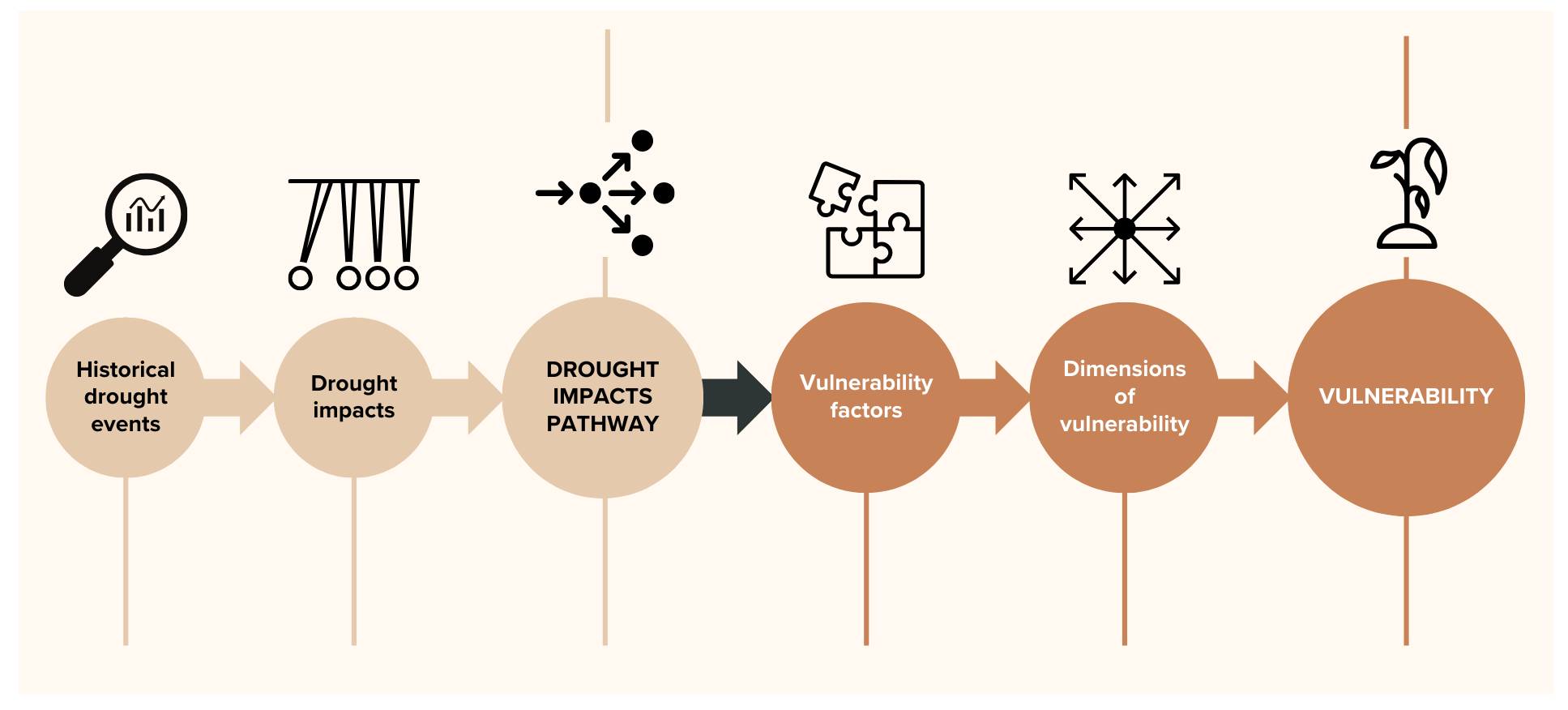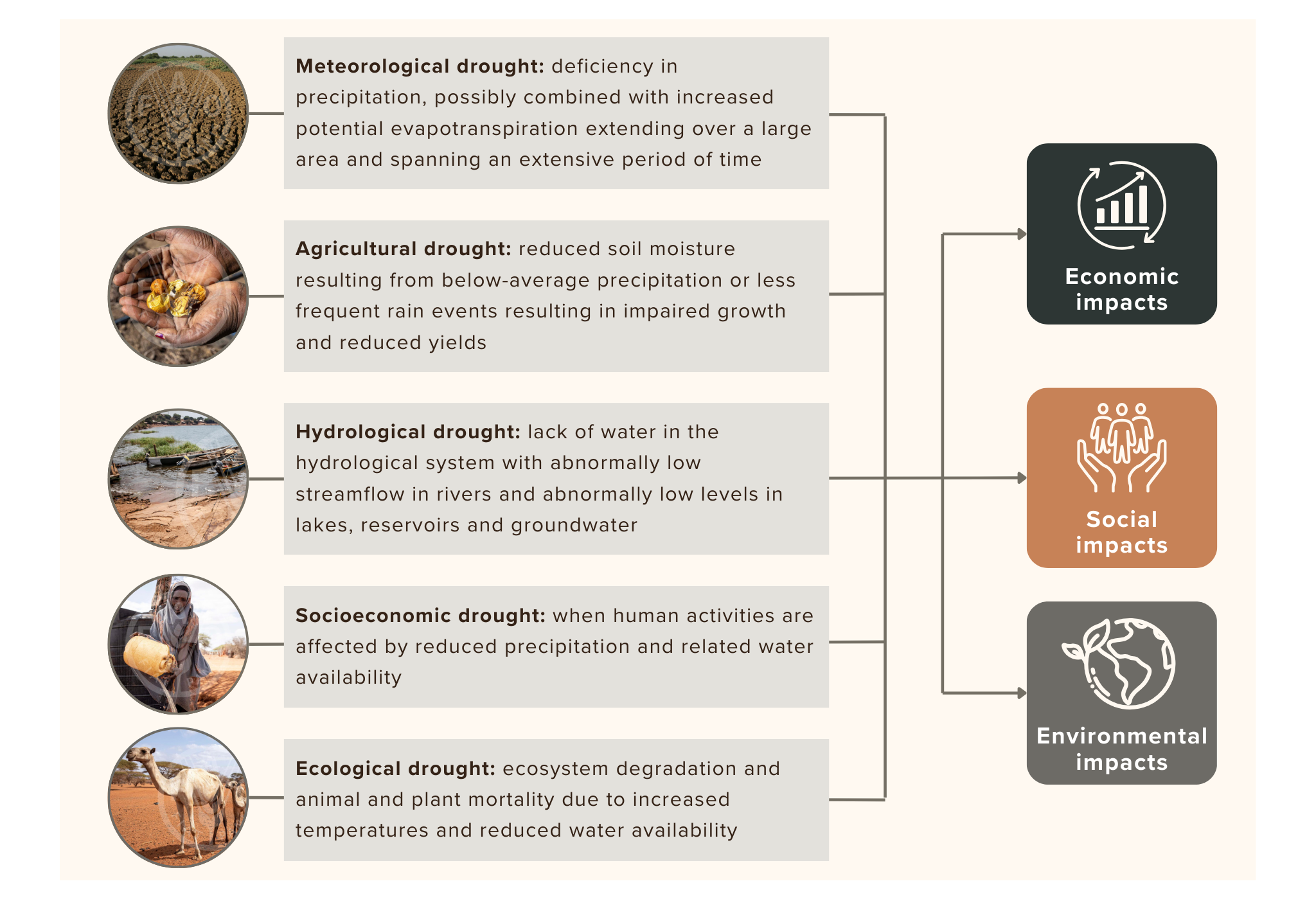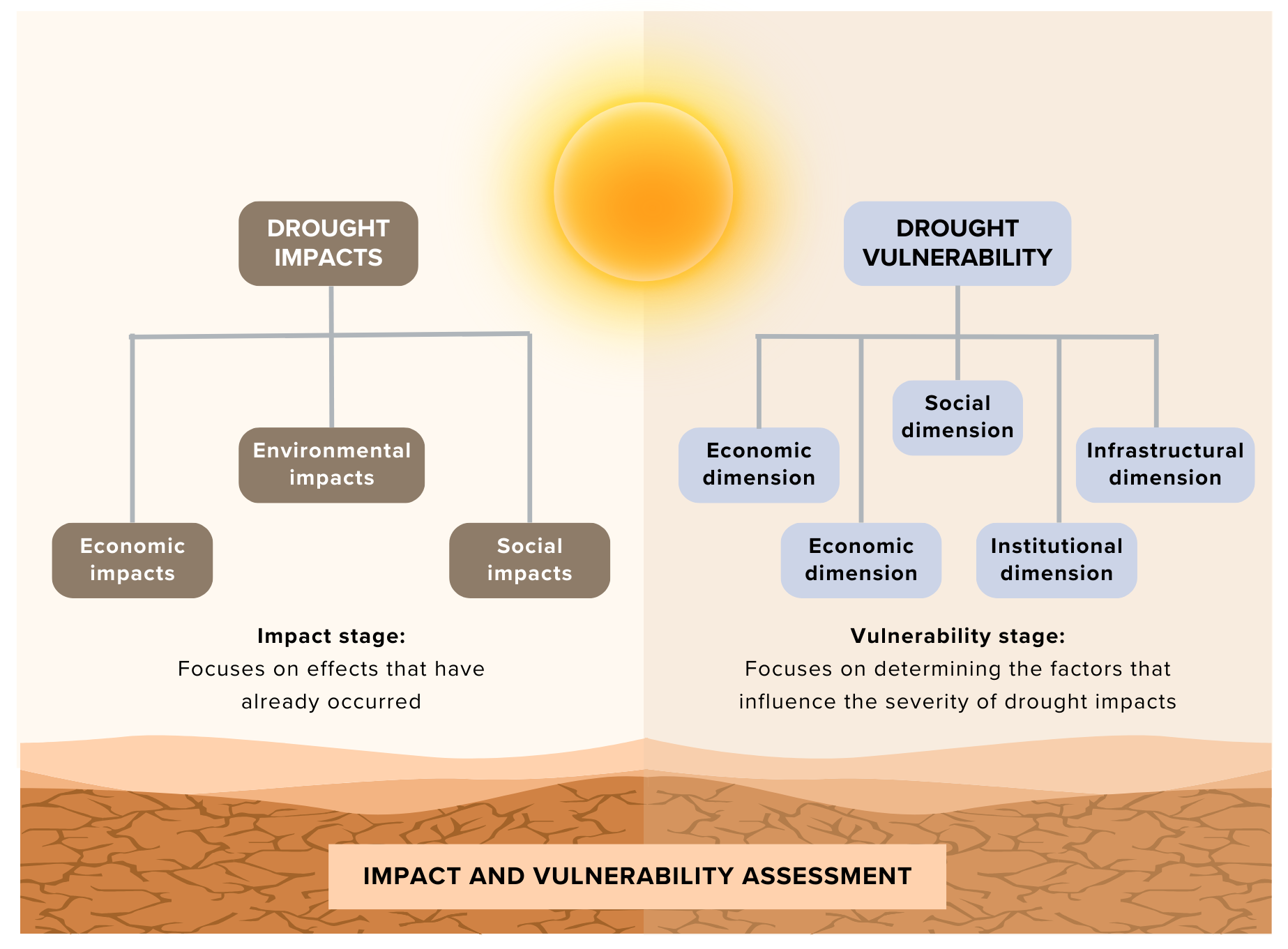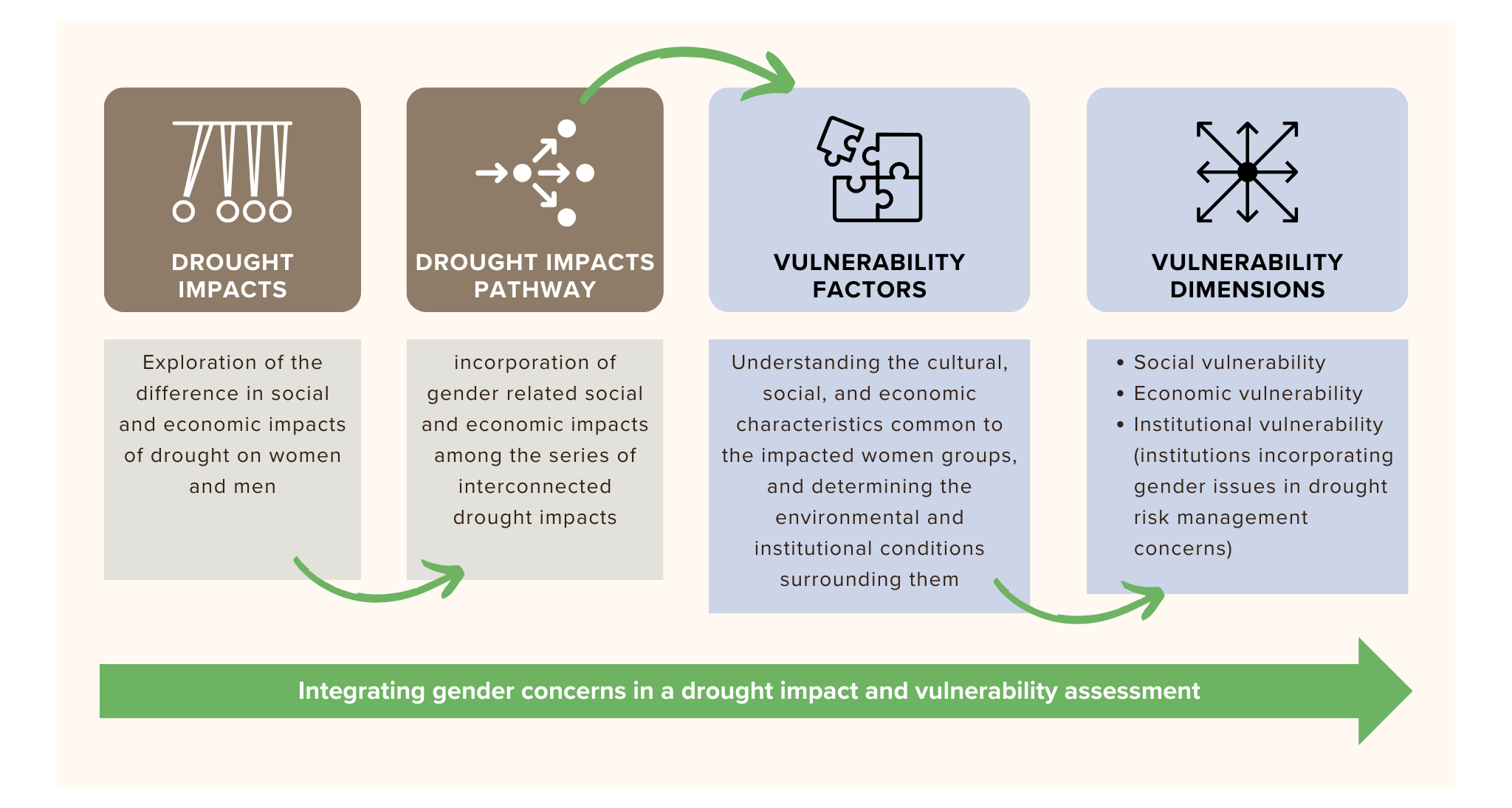
Concept and dimensions of drought impact and vulnerability
In I&V assessments, key components are the types of drought impacts, namely, economic, social, and environmental, and the dimensions of drought vulnerability, particularly the economic, social, infrastructural, environmental, and institutional dimensions.
The impact component is concerned with the historical, current, and future impacts of drought. In the assessment process, data gathering is focused on historical drought as this is the point where the areas impacted by drought are identified, and the characteristics of the drought event are described.
The periodicity of drought often limits the evidence and available information to understand drought events fully. This is why the review of historical drought impacts is the first step to building a systematic set of information about the predictable future impacts. The knowledge and information on the elements that influence the degree of drought impacts can help steer actions that will prepare the system for the occurrence of future droughts and will help mitigate the impacts of future droughts.
The vulnerability component involves exploring the primary causes of drought impacts and the reasons for the severity of the impacts experienced. In this Compendium, an I&V assessment is conducted along several stages and should generate analyses and outcomes that support the planning to reduce or minimize the consequences of drought.

The crucial stages of the I&V assessment process are determining the drought impact pathway and structuring the dimensions of vulnerability. A drought impact pathway is the simplified causal chain of drought impacts or the series of interconnections of drought effects. An impact pathway helps to identify the system units impacted by drought, and this pathway would be the basis for the investigation of the vulnerability factors. System units are the geographical areas, sectors, livelihoods, ecosystems, environmental functions, infrastructure, or economic, social, and cultural assets that have been adversely affected by drought. The characteristics of the impacted system units will form the vulnerability factors, and based on the identified vulnerability factors, the various dimensions of drought vulnerability are determined. Understanding the dimensions of vulnerability will enable planning for future drought responses, development of coping strategies at various levels, and implementation of long-term drought management risk measures.
TYPES OF DROUGHT – Drought is complex and different from other natural hazards. While drought originates from a deficiency of precipitation, it manifests in different types across the physical, agricultural, socioeconomic, ecological, and hydrological systems. Although meteorological (physical) drought begins from the lack of precipitation, the other types are outcomes of this deficiency.

Just like drought, the concept of vulnerability is complex. There is no single definition of vulnerability, and different disciplines interpret the term in different ways.
One of the most widely used conceptualizations of vulnerability comes from the Intergovernmental Panel on Climate Change (IPCC)’s Third Assessment Report, which defines vulnerability as a function of exposure, sensitivity, and adaptive capacity. This conceptualization is applied in both climate change and drought studies and research.
The United Nations Convention to Combat Desertification (UNCCD) identifies three components of drought vulnerability, namely social, economic, and infrastructural, to underscore drought vulnerability’s multifaceted nature.
In I&V assessments, vulnerability is generally measured and determined through proxy indicators. An investigation of these indicators – as used in different climate change and drought vulnerability studies that computed vulnerability indices – detected linkages between the IPCC and UNCCD definitions. From these linkages, along with the consideration of types of drought impacts, various dimensions of drought vulnerabilities can be conceptualized.

According to UNCCD, vulnerability can be defined through 3 dimensions:
- economic vulnerability, highly dependent on the economic status of individuals, communities, and countries;
- social vulnerability, linked to the degree of well-being of individuals, communities, and society; and
- infrastructural vulnerability, composed of the fundamental infrastructures crucial to the production of goods and sustainability of livelihoods.
The Compendium adds to this last dimension the presence or lack of technologies, structures, and other measures for drought risk management such as early warning system equipment.
ENVIRONMENTAL VULNERABILITY – The concept of environmental vulnerability relates to environmental impacts. The Compendium defines it as the dimension that involves the natural characteristics of areas susceptible to drought impacts. It hinges on biophysical features such as location, soil condition, vegetation, flora and fauna, etc., as well as the system’s geographical aspects like the site and situation of the place.
INSTITUTIONAL DYNAMICS – The institutional dimension does not originate from the UNCCD’s drought vulnerability definition or the types of drought impacts. This is because, unlike the other dimensions, the institutional dimension is not comprised of the inherent characteristics or properties of the system.
Drought is a factor external to the system, and this external hazard triggers the institutional dimension of vulnerability. To address its impacts and risks, drought is internalized in the institutional framework by either creating new institutions or building the capacity of old ones.
The primary focus in institutional vulnerability is how drought impact, vulnerability, and risk concerns are incorporated into the existing institutions or how new institutions are created to address these issues. The institutional dimension considers rule-based, organizational, and social structure-based institutions, and their institutional arrangements that guide actions on drought management

In conducting I&V assessments, it is crucial to recognize the interconnected nature of the system, interlinking parts, units, or elements. This is the primary rationale for outlining the impact pathway. The linkages among system units are also important factors in integrating gender concerns in the I&V assessment. The impacts of drought on women (and men) may not manifest as direct but as indirect impacts of drought. The gender component becomes more visible as the interconnections among system units are investigated.
Gender considerations are important aspects of social vulnerability and, to some extent, of economic and institutional vulnerability. The Compendium considers the incorporation of gender concerns an essential criterion for conducting I&V assessment, and it should be systematically integrated at the initial stages and throughout the assessment process. The incorporation of gender concerns begins by examining drought impacts to conceptualizing the drought impact pathway, determining vulnerability factors, and until the social, economic, and institutional dimensions of vulnerability have been examined and assessed.

I&V assessments: an iterative exercise
Vulnerability is a dynamic concept because its degree changes along with its factors. For example, poverty can be reduced over time, which inherently reduces the vulnerability to drought. As a process with a moving baseline, vulnerability requires regular evaluation. To avoid too resource-intensive processes of regular reviews, I&V assessment must be streamlined and optimized. This Compendium supports the definition of an optimized process.
